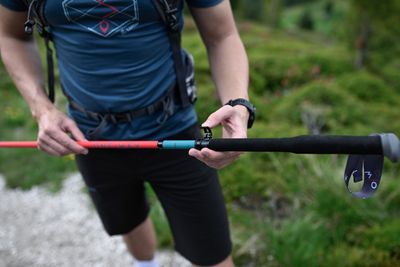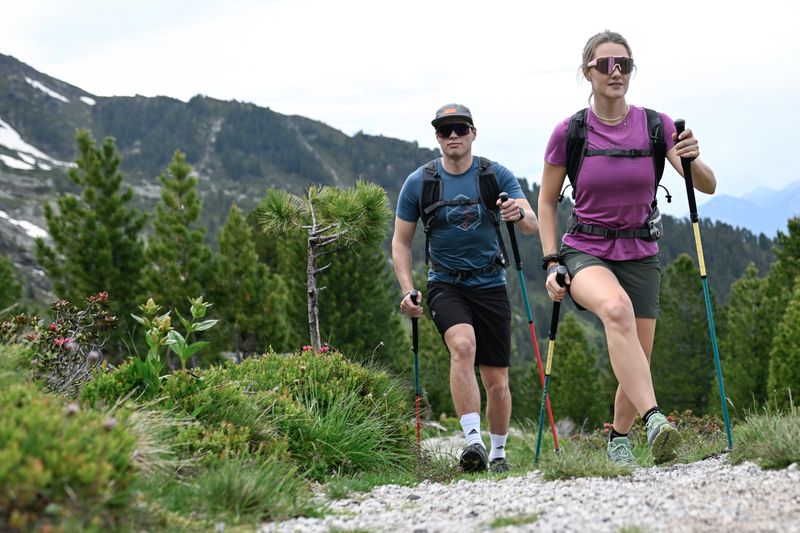Contents
Which trekking poles are right for you?
Trekking poles are more than just support on the trail—they give you balance on uneven terrain, ease the strain on your joints during descents, and provide extra stability on long hikes. But which model is the right match for your needs? And what should you really consider before buying?
Why use trekking poles in the first place?
If you’ve ever found yourself wondering whether trekking poles are really worth the effort of bringing along—you’re definitely not alone.
But there are plenty of convincing reasons to pack them, especially if you’re heading out on a longer hike, tackling steep ascents and descents, or carrying a heavier backpack where every bit of support and stability can make a noticeable difference.
- Improve your balance on uneven terrain
- Reduce pressure on knees and hips during descents
- Encourage a steady walking rhythm
- Engage your arms for better endurance
Depending on the terrain and the length of your hike, your gear needs can vary—so it’s worth taking a closer look at design, weight, and usability.
Trekking pole types—and who they’re best for
Trekking poles generally fall into two main categories: telescopic and foldable.
Telescopic poles

Tip: The MT AL 1 is a classic adjustable aluminum pole with a wide range of settings, an ergonomic grip, and solid handling—ideal for traditional hikes where durability and flexibility matter.
Foldable poles
These poles fold down into compact segments—like tent poles—making them incredibly lightweight and easy to pack. Great for trail running, speed hiking, or hut-to-hut trips where every gram counts.
The MTX Carbon from One Way is a standout here: ultra-light, foldable, and impressively rigid. Perfect for minimalist hikers who still want top-level performance.
Foldable and adjustable: the best of both worlds
Some models combine a small pack size with adjustable length. That means you can fold them away easily and still tailor the height to suit different terrains, gradients, or even multiple users.
The MTX Carbon Vario is a great example: made entirely of carbon, it offers stepless adjustment from 115–135 cm, with a grippy, extended handle. Lightweight but strong, it’s ideal for trekking, mountaineering, or trail running.
For a hybrid of carbon’s lightness and aluminum’s durability, check out the MTX Calu Vario Lite. A great pick for longer hikes where packability and stability are equally important.




What to look for when buying trekking poles
Your hiking style & duration: Whether you’re heading out for a casual day hike or a multi-day trek with a full pack—your destination and duration will influence your choice. Fixed-length poles are fine for gentle terrain, but for alpine trails or longer distances, go with adjustable models.
Weight & packability: If saving space and cutting weight are priorities, foldable models like the MTX Carbon or MTX Calu Vario Lite are your go-to. They fit easily inside or onto a backpack—especially useful when traveling by train or plane.

Grip comfort: The grip matters more than you think—especially on long hikes. One Way poles come with ergonomic, soft-touch handles that are easy on your hands and help prevent blisters.
Carbon vs. aluminum: Carbon is super light and absorbs vibration well, but it’s more fragile with lateral pressure. Aluminum is tougher and better for rugged use. Hybrid models like the MTX Calu Vario Lite offer a nice balance.
Accessories & add-ons: For snow, mud, or soft trails, larger baskets (like the Alpine Baskets) make a big difference. You can easily attach them to any One Way model.
>> Find the perfect length for your trekking poles here
Your questions, answered
Why should I use trekking poles?
Which is better: foldable or telescopic?
How do I find the right length?
Which is better: carbon or aluminum?
Are adjustable poles worth it?
What if I’m hiking in snow or mud?
Final thoughts: poles as personal as your adventure
From forest trails to mountain passes to multi-day hikes—the right trekking pole depends on where you’re going, how you hike, and what matters most to you. One Way’s poles prove that smart design, comfort, and durability don’t have to be complicated—they just need to work when it counts.
>> Explore our big range of trekking poles





